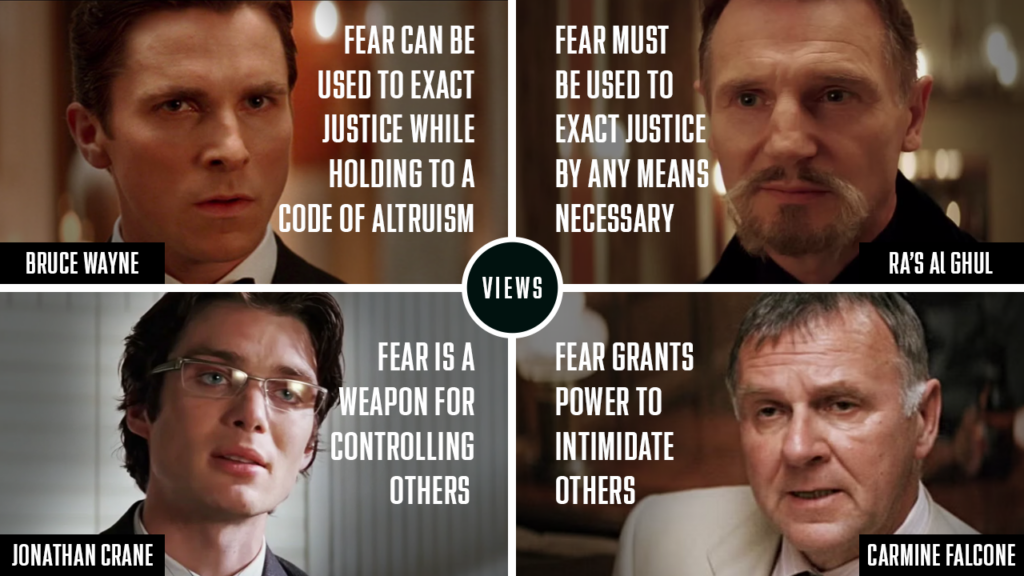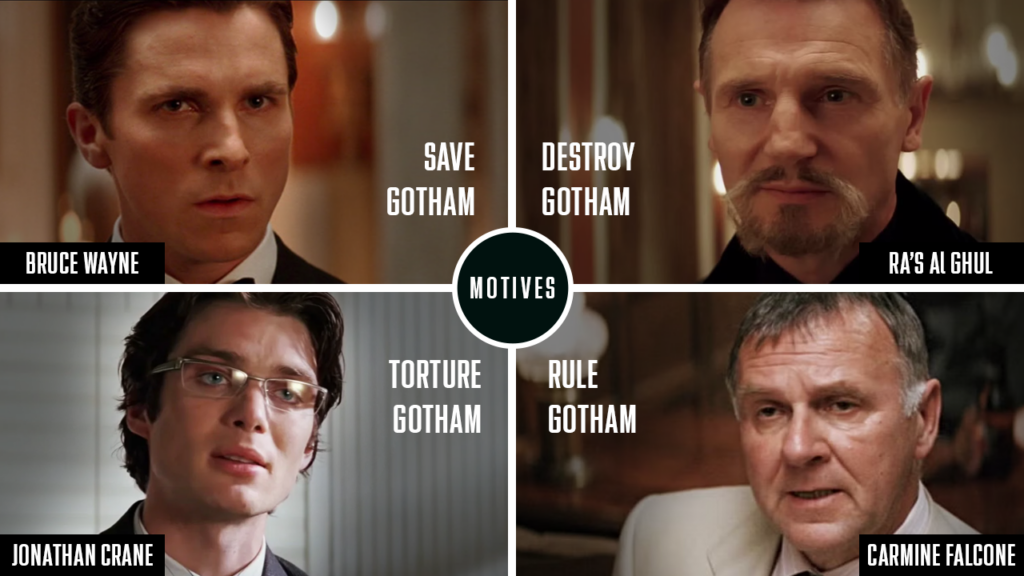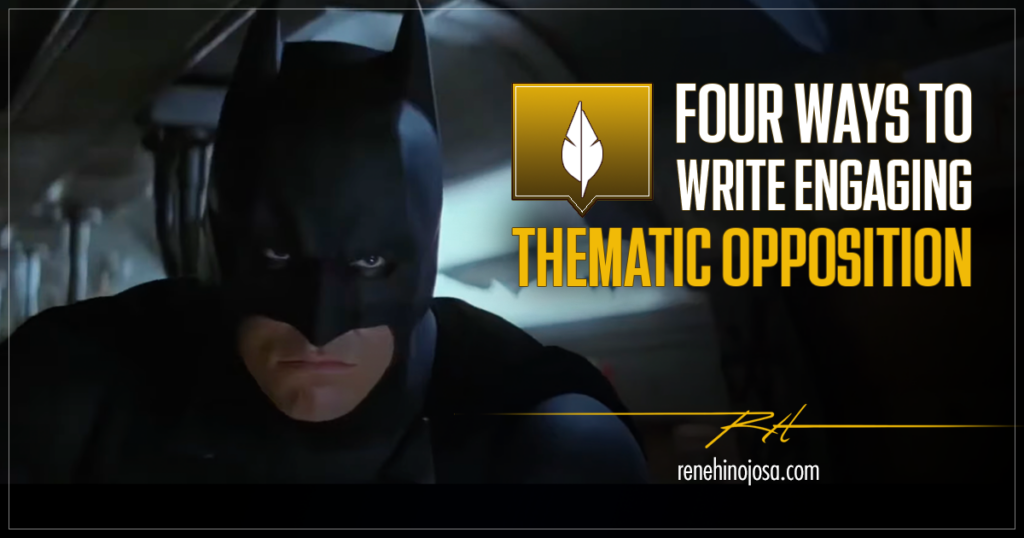Conflict drives story. It characterizes the protagonist’s inner struggle and pits them against obstacles and antagonists that challenge them at every turn. To immerse your audience in a richer and more complex narrative, you must be open to exploring multiple points of view through engaging thematic opposition.
Adding the right layers of thematic opposition adds complexity and tension to your story and creates a more immersive experience for your audience. But how do we add those layers? And how do we use them to explore the many facets of our theme? To answer those questions, I’ll explore how to write engaging thematic opposition using Batman Begins as a case study.
Four Ways To Write Engaging Thematic Opposition:
What Is Thematic Opposition
While your theme serves as your story’s truth, it’s important to remember the objective and subjective nature of that truth. Truth is inherently objective but also subjective when filtered through the views, values, and motives of different people. The basic approach is to start with two conflicting opinions via your protagonist and your antagonist. But what if you added additional layers to this conflict by including the views of your other characters?
Jack Truby introduced the idea of four-corner opposition in his book The Anatomy of Story. This approach explores theme through at least four distinct characters, each with their own views, values, and motivations. This form of thematic opposition contributes to tension and even brief moments of alignment between your characters, adding to the complexity of your narrative and making for a more immersive story.

Let’s explore how Batman Begins masterfully uses engaging thematic opposition to explore the many facets of its central theme of fear.
Opposing Characters
Start with your antagonist, then layer in additional characters that directly oppose your protagonist. Make the difference between them as compelling as possible while ensuring each uses unique tactics to attack the protagonist’s weaknesses.
In Batman Begins the central theme of fear is explored through the character of Bruce Wayne as he embarks on a journey into the criminal underworld to find the means to exact justice. While in prison, he’s visited by a man who calls himself Ducard—a representative for Ra’s Al Ghul, the leader of the secret society known as the League of Shadows.
What makes Batman Begins so thematically interesting is that the hero and the main antagonist share distinct similarities. Both want the means to exact justice in the world. But while Bruce seeks a more altruistic path, Ducard, who is later revealed to be the real Ra’s Al Ghul, is bent on doing whatever is necessary to achieve his goals—even if it means killing innocent people.
As the story unfolds, we’re also introduced to two other antagonists. Carmine Falcone is a crime boss who wields the power of fear through intimidation and control. While Jonathan Crane is a psychopath who thrives on inducing fear in his victims as the Scarecrow. Unbeknownst to them, they are both pawns in Ra’s Al Ghul’s grand scheme to purge Gotham of its criminal element.

Opposing Views
Place each character in conflict, not just with the protagonist, but also with each other. Each of them should have their own beliefs and points of view as they relate to the story’s central conflict and thematic truth.
After Carmine Falcone orders the assassination of the man who killed his parents, Bruce Wayne decides to stand up to him in a vain attempt to show that he isn’t intimidated by him. Falcone responds by showing how powerful he really is.
This altercation drives Bruce to leave Gotham, ultimately bringing him to Ducard and the League of Shadows. But while the two of them share the same views about using fear as a means to exact justice, Bruce’s desire to maintain a sense of altruism ultimately conflicts with Ducard’s need to do whatever is necessary to root out evil.
Bruce leaves the League of Shadows and returns to Gotham, taking a cue from Falcone and adopting the power of fear to intimidate criminals as Batman. This ultimately leads to Falcone being jailed, where he immediately appeals to Jonathan Crane to obtain his release. Falcone tries to use his usual intimidation tactics only to discover that Crane’s weaponization of fear is more terrifying than his.
Each character’s view of fear creates an elaborate web of conflict that explores all sides of the story’s thematic argument.

Opposing Values
Introducing conflicting values makes a compelling story. By showing how your characters differ in philosophy, you can exponentially increase the level of conflict, allowing you to explore multiple facets of your theme.
Falcone values money and power, while Crane values the power he achieves by psychologically torturing his victims. Each has their own beliefs and ways of thinking, revealing what they value most. Likewise, Bruce Wayne and Ra’s Al Ghul each value a society free of corruption. But while Bruce is committed to saving the city and its citizens, Ra’s is willing to do whatever is necessary to purge Gotham of corruption because he believes that the city is beyond saving.
Each character’s values contribute to the overall picture of the central theme, exploring all sides of the thematic argument. This multi-faceted approach makes the story more relatable to a diverse audience, allowing them to understand and even identify with different points of view.

Opposing Motives
Every character in your narrative ultimately wants something, and each has their own reasons for wanting it. Weave their views and values together to reveal the underlying motives driving them toward their goals.
While Falcone is motivated by greed and Crane by his need for control, Bruce Wayne and Ra’s Al Ghul share a mutual desire for justice. When you understand that both of them are motivated by their own experiences with injustice, their climactic battle becomes less of a physical contest and more of a war of ideals.
Batman Begins masterfully works because its protagonist and main antagonist are virtually aligned in their views and values, but their motives are diametrically opposed. In the end, only one can emerge victorious to personify the validity of the story’s thematic truth.

Summing It Up
Understanding how to write engaging thematic opposition requires you to explore the many facets of your thematic argument. Look at your characters and explore how their views, values, and motives all conflict with one another. Then, use that conflict to inject complexity and tension into your narrative.
I hope this article provided you with some insight on how to write engaging thematic opposition. I invite you to explore the concept for yourself. Look for ways to incorporate it into your work. And above all, keep writing!
Until next time,

